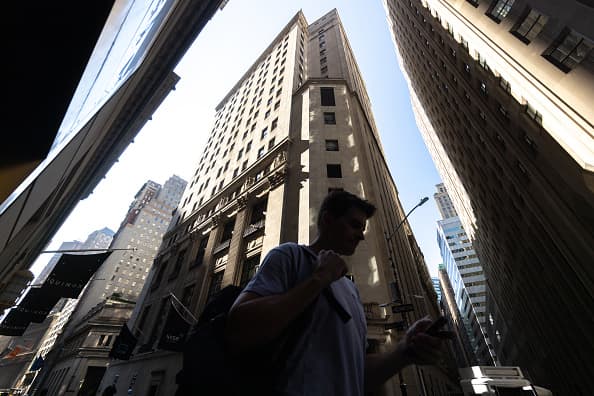
Things could get a lot more dicey. Wall Street is about to wrap up one of the more turbulent months of the year after the S & P 500 — which started August posting its worst day since 2022 — recovered all its losses in just three short weeks and is once again approaching all-time highs. The broader index topped 5,660 in July; it was last just a stone’s throw away from that milestone. But next month’s set-up gets more challenging. September is seasonally the weakest month on the calendar, averaging a decline of 1.2% historically, Bank of America Securities technical strategist Stephen Suttmeier pointed out this week. On top of that, investors will have to deal with the Federal Reserve’s upcoming two-day policy meeting on Sept. 17-18. The Fed is widely expected to lower rates. The question is by how much. .SPX YTD mountain S & P 500 “There’s going to be a lot of headline risk over the next few weeks,” said Jay Woods, chief global strategist at Freedom Capital Markets. “And now that we’re through earning season, those headlines will be under the microscope more than ever.” Until then, investors will have to wade through a stacked economic calendar — with the U.S. jobs report coming next week, and inflation data the next — to obtain more clues on what to expect from the Fed going forward. The key to interest rates The path of easing monetary policy will very much be on investors’ minds all through September, adding significance to economic reports between now and the Fed meeting. Of note, August nonfarm payrolls data is due out Sept. 6, while consumer and producer price indexes are set to release Sept. 11-12. Any indication from the labor market or inflation data indicating investors will have to revisit their rate cut expectations for the balance of the year has the potential to hurt equities. Currently, Fed funds futures pricing shows the key overnight lending rate dropping 1 percentage point in 2024, per the CME Group’s FedWatch tool. It’s an expectation some observers say is overly dovish when taken together with some recent data showing the U.S. economy continues to remain robust. The Atlanta Fed GDPNow model estimates real GDP growth of 2.5% in the third quarter of 2024, revised higher from 2% on Aug. 26. “I think that expecting the Fed to cut 100 basis points in four months is a bit excessive,” said CFRA’s Sam Stovall. “The Fed has been saying we don’t want to reignite the flames of inflation, we want to make sure that the fire is extinguished before we walk away from the campsite. So, I think the Fed will cut interest rates in September, and then we’ll monitor data to decide.” “Maybe we take November back off the table, if the data could continue to come in stronger than expected,” Stovall added. “It’s still a fluid situation, because the Fed remains data dependent.” Next week’s jobs report for August is expected to be a market mover after the disappointing weakness in the July payrolls figures sparked fears of slowing economic growth, contributing to the Aug. 5 sell-off. Wall Street is anticipating a stronger report this time around. Economists are forecasting the U.S. economy to have added more than 160,000 jobs in August, up from 114,000 in July, according to FactSet. The unemployment rate should ease back to 4.2%, from 4.3%, consensus estimates show. The August consumer price index is set to show yearly inflation pulling back to 2.6% from 2.9% on a yearly basis, FactSet data showed. The producer price index for the same month is set to show inflation easing to 1.7% from 2.2%. Broadening performance Market bulls expect there is still upside to the S & P 500 this year, so long as it can get through the next two months with the Fed meeting and the November election. This week, Bank of America’s Suttmeier, who’s watching key technical levels now that the S & P 500 is once again reaching its prior peak, said there’s a path toward 6,000 for the S & P 500 if holds above key support at 5,560. Over the near-term, however, many see that the rotation out of tech stocks and into this year’s market laggards will continue. This trend was underscored by Nvidia this week, when the cool reception to its earnings results failed to drag the market as much as investors feared. To be sure, longer-term investors may want to maintain exposure to Big Tech, which could rally closer to year end. “I still think that there is some upside potential between now and the end of the year, but I think we have to get through this rough patch first,” Stovall said. Week ahead calendar All times ET. Monday, Sept. 2 Markets closed for the Labor Day Holiday. Tuesday, Sept. 3 9:45 a.m. S & P PMI Manufacturing final (August) 10 a.m. Construction Spending (July) 10 a.m. ISM Manufacturing (August) Wednesday, Sept. 4 10 a.m. Durable Orders final (July) 10 a.m. Factory Orders (July) 10 a.m. JOLTS Job Openings (July) 2 p.m. Fed Beige Book Earnings: Hewlett Packard Enterprise , Hormel Foods , Dollar Tree Thursday, Sept. 5 8:15 a.m. ADP Employment Survey (August) 8:30 a.m. Continuing Jobless Claims (08/24) 8:30 a.m. Initial Claims (08/31) 8:30 a.m. Unit Labor Costs final (Q2) Earnings: Broadcom Friday, Sept. 6 8:30 a.m. August Jobs Report
EMEA Tribune is not involved in this news article, it is taken from our partners and or from the News Agencies. Copyright and Credit go to the News Agencies, email news@emeatribune.com Follow our WhatsApp verified Channel




